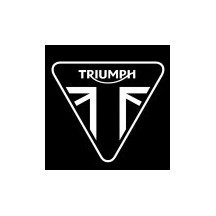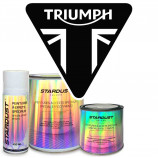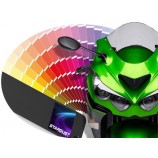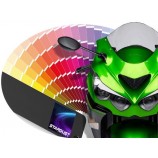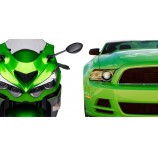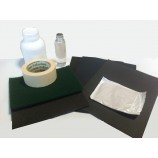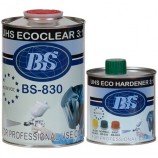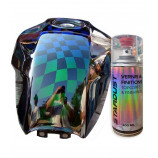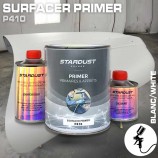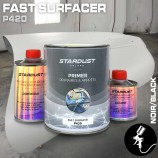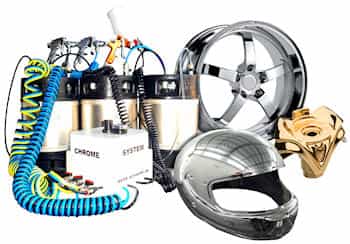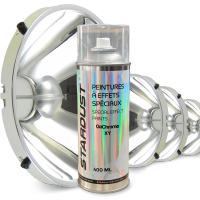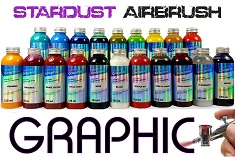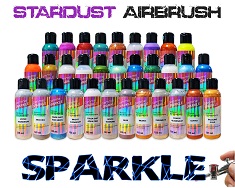In addition to special effect paints, we specialize in the preparation of paints for bodywork and we offer the service of formulating paints made exactly according to the color codes of European motorcycles and precisely the color codes of Triumph motorcycles.
Our team of colorists prepares all Triumph manufacturer colors and ships them within 24 hours in France and 48-72 hours in Europe.
The ordering method is made easier thanks to our product page "Triumph paint base matt version" which you will find below in the category.
You must indicate in the box provided (basket page) the Triumph color code, or send it to us by email at orders@stardustcolors.com.
On this page, you will simply have to select one of the packaging offers which range from 400ml aerosol versions or paint pots from 0.25 L ready to use, to kits of 1 and 2 Liters (with pure paint and separate thinner).
Depending on your project, this could be a small touch up on a part like a fender, or a full paint job on the entire fairing of the bike, you will need 250ml to 1 litre. For some very large motorcycles with cases and windscreens, it may be necessary to have a higher quantity.
You will also need to provide a primer, which can quite rarely be an adhesion primer, and more frequently a filling primer (primer*), and in all cases, a motorcycle varnish. We offer these varnishes in pots and "in spray", always in a two-component polyurethane version.
Triumph brand motorcycle color codes
Nowadays, one encounters more and more rarely "opaque and solid" type paints, as was commonly done in the years from 1960 to 2000. This type of paint could be produced in a version that the we call gloss lacquers, also commonly called “direct gloss 2C” paints. Since the 2000s, this type of simple color has become increasingly rare. Today, almost all motorcycle colors consist of pearlescent and metallic “1C” paints.
The difference between pearlescent and metallic paint comes from the type of pigments used, i.e. either pearlescent or aluminum pigments. In view of the exceptional properties of mother-of-pearl, much superior to that of aluminum pigments, which are dull and opaque in comparison, most paints, even if they bear the name "metallic", with the initial "MET" in the reference color, are actually pearlescent paints. These allow more transparency and amplified shine.
These types of modern shades are applied, not with one glossy layer, but on the contrary with several thin layers. Most Triumph paints are therefore single-component type paints, which in the automotive field are called “matt base” paints to be varnished. They are also often called "two-coat" paints, because they must be applied in two stages with first, the paint, followed by the varnish. Depending on each Triumph color code, it may be necessary to apply a specific undercoat. This primer may simply be a primer, which must be colored to a precise gray tone (RAL reference – consult our colorist for more information) and sometimes it may be a specific undercoat which takes the form of a colorful paint. In such a case, it is not a two-coat Triumph paint, but a three-coat paint which will offer a richer color, in terms of depth and iridescent effect.
The history of the manufacturer Triumph
Triumph was originally a German company, which later became an English company, following the move of its founder from Germany to England. Its founder was only 20 years old at the time. This precocious entrepreneur had founded his own company (in 1884) for the marketing of bicycles.
Originally the company bears his name "Bettmann" of German origin, then in 1886 he gave it the name of Triumph. From that year, he benefited from the partnership and the help of the Dunlop company, which manufactured tires at the time. It was also two years after the date of creation that the founder accepted the arrival of a new partner, who brought a decisive influence to the business of selling bicycles. The latter pushed the company to become, no longer a simple retailer, but a bicycle manufacturer.
With the help and loan of money from their family, the 2 young partners bought a small factory and began manufacturing their first Triumph bicycle in 1889. In 1896, they opened a second factory in Germany in the city of origin Nuremberg, thanks to a dazzling success.
In 1898, they will add an engine to their bicycle and it is the real beginning of the production of the first Triumph motorcycles. In 1904, it was the start of the first motorcycles made with a unique and innovative design, which made the Triumph brand famous.
In 1907, a very large factory was inaugurated with an industrial production capacity of several thousand mopeds and motorcycles per year. The success of the company will experience a real surge with the start of the First World War, because it will become the supplier of the English and American armies, with an order for 30,000 motorcycles. The quality of Triumph machines will become famous and they will be called "trusty Triumph", which means trusted Triumphs.
As early as the 1920s, Triumph became one of Britain's leading manufacturers for the production of motorcycles and automobiles, with nearly 4.6 hectares of manufacturing area in the main factory and a production of 30,000 motorcycles every year!
Unfortunately, during the Second World War, their main manufacturing site suffered a very severe bombardment and was almost completely razed. The post-war period was a period during which the brand devoted itself to speed racing and various international grand prix. Today, the Triumph brand is the only surviving brand in the motorcycle industry in England.
Where to find the color code of your Triumph motorcycle ?
The manufacturer's color reference for Triumph motorcycles can be found on the motorcycle's purchase booklet. If you don't have this one, then you'll need to do a little research and some effort:
First, get in touch with your local dealer. This should normally be able to give you precise information on the name and code of your shade.
If this is not possible, then you still have a solution, that of going to the discussion forums dedicated to the Triumph brand. These Internet forums share a lot of information from most users all over the world. If you are lucky, you will find all the information you are looking for about your motorcycle, even if it is decades old.
You can contact our team, by email or by phone, to validate a color code that you already have. We cannot do the code search for you, as a single code is not intended for a single model, nor for a single year of Triumph motorcycles. It is therefore impossible to search by model, and for a single color, there may be a large number of color code variants.
The iconic colors of Triumph motorcycles
Triumph is probably one of the oldest motorcycle brands and you can find color references that are over 80 years old. There aren't exactly any specially famous shades for Triumph motorcycles.
We have a long list of color codes for this English brand, with references spanning decades.
As for all other types of motorcycles, the designation of a manufacturer's color is done with two elements: the color code and the name of the color. The secondary information does not allow the search or the identification of a hue.
Here are some examples from our database :
18 BLUE NEON SPEED TRIPLE TRIUMPH MOTORCYCLES 2001 -
19 BLUE TRIUMPH MOTORCYCLES
19 NEW WHITE TRIUMPH MOTORCYCLES 1966 - 1967
19 BLUE TRIUMPH MOTORCYCLES 2002
CL CARDINAL RED TRIUMPH MOTORCYCLES 1997 -
CL FIRST COAT TRIUMPH MOTORCYCLES 1997 -
CM TORNADO RED TRIUMPH MOTORCYCLES 1998 -
CP SUNSET RED TRIUMPH MOTORCYCLES
CQ NUCLEAR RED TRIUMPH MOTORCYCLES 2000
Peugeot motorcycle color code
Husqvarna motorcycle color code
SACHS motorcycle color code
BMW motorcycle color code
KTM motorcycle color code
MBK motorcycle color code
Minimize
